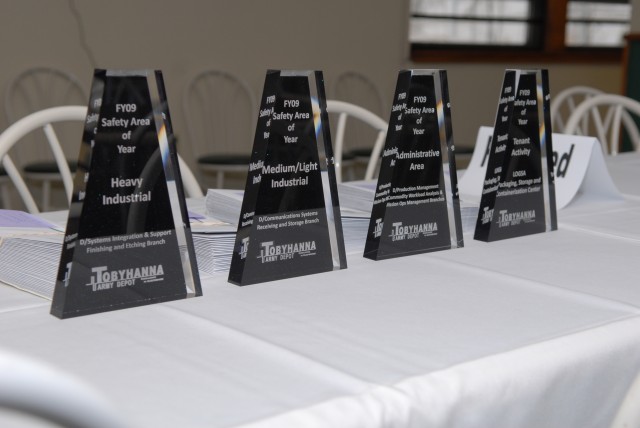TOBYHANNA ARMY DEPOT, PA. - Top-rated depot and tenant organization safety programs recently competed for the 2009 Safety Area of the Year Awards.
Three directorates and one tenant agency were recognized for their contributions to Tobyhanna's safety mission. The Communications Systems Directorate Receiving and Storage Branch claimed the Medium/Light Industrial Area; the Production Management Directorate Commodity Workload Analysis and Mission Ops Management Branches earned first place in the Administrative Area; the Systems Integration and Support Directorate Finishing and Etching Branch, took top honors in the Heavy Industrial Area, and Logistics Support Activity (LOGSA) Packaging, Storage and Containerization Center (PSCC) walked away with the Tenant Activity Award.
The annual awards acknowledge cost centers that have outstanding safety programs and individuals whose performances have best supported the depot's safety mission. It also allows cost centers the opportunity to identify intentional and active involvement in the depot's occupational safety and health programs.
Cost centers are categorized by heavy industrial, light industrial, administrative and tenant activities. Nomination packages point out how the cost center meets the following Voluntary Protection Program categories: management leadership and employee involvement, worksite analysis, hazard prevention and control, and safety and health training. Additional items that contribute to a safety program include the results of annual safety inspections performed by the Safety Division, quarterly self-safety inspections, injury and accident information, and completion and availability of Job Hazard Analysis in the work area.
The Administrative Area Award was presented to two cost centers in the Operations Management and Analysis Division. Due to similarity of the workload within the branches, they conduct a joint home team meeting and have one Safety Star Point assigned.
"The Safety Star Point and Personnel in both branches are extremely proactive and continuously elevate situations for discussion at our Home Team Meetings," said Karen Jantz, chief of the Mission Operations Management Branch.
"Kelly Daniel [Safety Star Point] should receive top accolades. She is a conscientious and enthusiastic role model for her peers when it comes to safety," Jantz said, pointing out that many of the team's recommendations for innovative measures came from Kelly.
According to the nomination package, area personnel are constantly on the lookout for their co-workers, they correct hazards when they can, call in work orders and pass-up concerns that need to be addressed. In addition, scorecard metric information indicates these branches have not had any recordable injuries or illnesses in over eight years.
"The Safety Star Points in our organization go above and beyond," said James Bochicchio, former chief of the Commodity Workload Analysis Branch. "Their use of visual aids and demonstrations keep safety on the minds of our employees. They even disseminate articles on safety issues outside the workplace that can be shared with family members. As a result, we have a team that is truly committed to a safety lifestyle."
Due to the nature of the hazards in the Finishing and Etching Branch, there is an extensive job hazard analysis (JHA). Shop personnel review it annually and then post it in the work area.
Personnel are trained to respond to a myriad of safety concerns. To ensure all training requirements are met, employees have developed a training log and placed it as a desktop icon. In addition, shop personnel perform on-the-spot corrections when a hazard is identified. If hazards cannot be corrected by shop personnel, a work order is submitted or the Safety Division is contacted.
Ensuring continuous improvement, officials share safety information published in safety bulletins, presented at Safety Star Point or home team meetings, and during random inspections. Employees in the branch are nearing 2,000 days without a recordable injury or illness, according to the nomination package.
On average, the Receiving and Storage Branch receives about 1,200 shipments per month and has not had a recordable injury or illness in about 900 days. The nomination package states the award winners work together on a daily basis to remind each other to wear proper Personal Protective Equipment and follow safe work practices, according to the nomination package.
"Safety comes first," said Philip Price, branch chief. "Everyone looks out for each other."
As a result of safety assessments, employees added backup alarms and mirrors to older forklifts, installed cross supports on the storage rack system and replaced damaged flooring supports. An ergonomic assessment resulted in the purchase of several new work stations and chairs.
LOGSA PSCC completed 16 self-safety inspections, conducted industrial hygiene surveys and updated several types of PPE including hard hats, respirators and safety glasses. Employees also maintain Material Safety Data Sheets for all chemicals in the testing facility.
Safety is one of six PSCC business objectives under their Strategic Implementation Plan. The organization educates personnel in safe practices at work, but at home as well, according to the nomination package. Some topics covered were Family Road Trip Must Haves, Summer Travel Tips and Do Not Flush Drugs.
Tobyhanna Army Depot is the Defense Department's largest center for the repair, overhaul and fabrication of a wide variety of electronics systems and components, from tactical field radios to the ground terminals for the defense satellite communications network. Tobyhanna's missions support all branches of the Armed Forces.
About 5,600 personnel are employed at Tobyhanna, which is located in the Pocono Mountains of northeastern Pennsylvania.
Tobyhanna Army Depot is part of the U.S. Army CECOM Life Cycle Management Command. Headquartered at Fort Monmouth, N.J., the command's mission is to research, develop, acquire, field and sustain communications, command, control computer, intelligence, electronic warfare and sensors capabilities for the Armed Forces.


Social Sharing